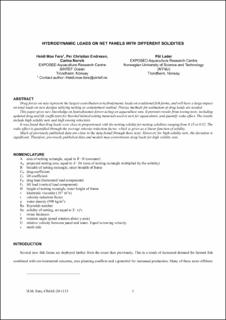| dc.contributor.author | Føre, Heidi Moe | |
| dc.contributor.author | Endresen, Per Christian | |
| dc.contributor.author | Norvik, Carina | |
| dc.contributor.author | Lader, Pål | |
| dc.date.accessioned | 2023-06-29T13:34:20Z | |
| dc.date.available | 2023-06-29T13:34:20Z | |
| dc.date.created | 2020-11-19T12:55:19Z | |
| dc.date.issued | 2021 | |
| dc.identifier.citation | Journal of Offshore Mechanics and Arctic Engineering. 2021, 143 (5), . | en_US |
| dc.identifier.issn | 0892-7219 | |
| dc.identifier.uri | https://hdl.handle.net/11250/3074384 | |
| dc.description.abstract | Drag forces on nets represent the largest contribution to hydrodynamic loads on traditional fish farms, and will have a large impact on total loads on new designs utilizing netting as containment method. Precise methods for estimation of drag loads are needed.
This paper gives new knowledge on hydrodynamic forces acting on aquaculture nets. It presents results from towing tests, including updated drag and lift coefficients for Raschel knitted netting materials used in nets for aquaculture, and quantify wake effect. The results include high solidity nets and high towing velocities.
It was found that drag loads were close to proportional with the netting solidity for netting solidities ranging from 0.15 to 0.32. The wake effect is quantified through the average velocity reduction factor, which is given as a linear function of solidity.
Much of previously published data are close to the data found through these tests. However, for high solidity nets, the deviation is significant. Therefore, previously published data and models may overestimate drag loads for high solidity nets | en_US |
| dc.language.iso | eng | en_US |
| dc.publisher | ASME | en_US |
| dc.subject | Stress | en_US |
| dc.subject | Drag | en_US |
| dc.subject | Wakes | en_US |
| dc.subject | Containment | en_US |
| dc.title | Hydrodynamic loads on net panels with different solidities | en_US |
| dc.title.alternative | Hydrodynamic loads on net panels with different solidities | en_US |
| dc.type | Journal article | en_US |
| dc.type | Peer reviewed | en_US |
| dc.description.version | acceptedVersion | en_US |
| dc.source.pagenumber | 7 | en_US |
| dc.source.volume | 143 | en_US |
| dc.source.journal | Journal of Offshore Mechanics and Arctic Engineering | en_US |
| dc.source.issue | 5 | en_US |
| dc.identifier.doi | 10.1115/1.4049723 | |
| dc.identifier.cristin | 1849857 | |
| dc.relation.project | Norges forskningsråd: 237790 | en_US |
| cristin.ispublished | true | |
| cristin.fulltext | preprint | |
| cristin.fulltext | postprint | |
| cristin.qualitycode | 2 | |
